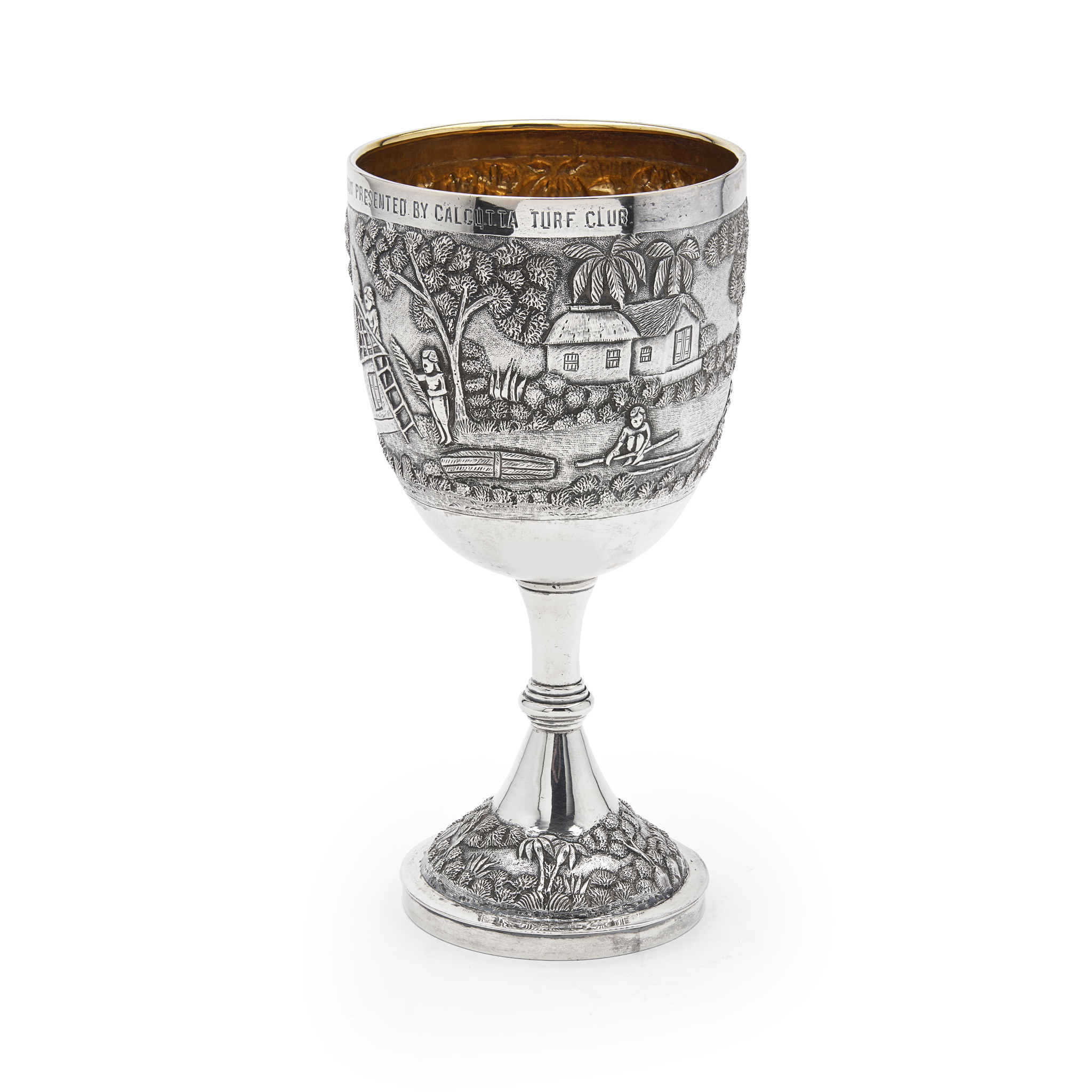CALCUTTA - AN INDIAN PRESENTATION ‘TURF CLUB’ TROPHY
UNMARKED, LATE 19TH
Estimate: £400 - £600
Auction: The Fiona Buchanan Indian Silver Collection | Wednesday 4th March at 10am
Description
The deep bowl with gilt interior and a heavily chased depiction of pastoral life, the border, engraved ‘1896 TOLLYGUNGE CLUB HORSE AND DOG SHOW PRESENTED BY CALCUTTA TURF CLUB’ to a knopped stem and domed circular foot with similar chased decoration
Dimensions
18.3cm high, 9oz
Footnote
Still in existence, the Tollygunge Club was founded in 1895 for British Merchants by the Scottish banker, Sir William Dixon Cruickshank (1845-1929). A portrait of him is in the collection of the National Gallery, London by H. Walter Barnett (NPG x45266),
The club was originally opened as an equestrian institution and focused mainly on riding and equestrian endeavours a clear link to this cup, only a year after its opening. The club still hosts annual animal shows where members bring their pets to compete for prizes.
Further literature: Pradip and Amita Das, `The Tollygunge Club Since 1895’ 2088
Introduction
Lyon & Turnbull is delighted to offer a collection of 19th and early 20th-century Indian silver composed over the last twenty years by Fiona Buchanan.
Despite having an interest in silver and antiques from an early aged, fueled by trips to the bustling Portobello Road and Edinburgh’s small weekly auctions it took some time to fall on her preferred subject, Indian silver. Fiona’s interest was first in this area piqued after discovering a collection of silver at the Midlothian auction house Thomson Roddick & Metcalf in 2007. With a keen eye, Fiona was able to discern that the collection was in fact of Indian origin, and showcased the work of the continent her family knew well, perhaps through osmosis of the stories from her father’s time in India as a Forestry Officer at the beginning of the 20th century.
The silver that forms this collection was mainly made for British expatriates during the Raj. Their tastes were taken into consideration and tableware that could be found at home was designed to suit their European styles, directly copying fashions of London and Edinburgh. However, both the craftsmen and the clientele could not help but be influenced by the various styles that each region traditionally offered, and it is this melting pot which makes Indian silver so unusual and unique.
Unlike British silver which is rigorously protected by hallmark laws, the silver of India is vastly inconsistent with regards to the purity of the silver. In the late 19th century much of the silver used was from melted coinage, the rupees of the British raj did have a standard of 91.7% silver but could not always be relied upon, particularly, if for example coinage had been imported from other areas, and a mixed alloy created. Furthermore, the discovered silver in Nevada in North America was also used and shipped on a journey via England where it was refined and then found its way to Bombay, but this too was untested. It must be noted, that, on the other hand, the silverware of the region of Kutch has been analysed and rarely tests less than 96% with some artefacts testing at 98% silver, but this merely confirms the inconsistencies across the country. This purer alloy does have practical advantages meaning the silver is softer to work and create the highly embossed and finely finished designs. Silver as a craft is well regarded and the word in Hindi is derived from moonlight, meaning it has always held spiritual connotations, the respect and care can clearly be seen in the intricate designs, stretching further to those that often portray the Hindu deities.
The collection highlights feature silver from the main regions of Lucknow, Madras, Kashmir, Kutch and Calcutta. Fiona visited Calcutta and even sought out the factory of Hamilton & Co., one of the most respected Indian silver firms. Identified primarily by the more austere fashion more suited to the European tastes, the highlight of the collection lot 49 the tea chest was made by this firm as well as lot 24 the sugar cane scroll holder.
The seven principal regions with hybrid Indian decoration which are mentioned in Wynyard Wilkinson’s seminal publication The Silver Manufactures of India 1858–1947, are as follows; Bombay, Burma, Calcutta, Cutch, Kashmir, Lucknow and Madras. Within Fiona’s collection, Madras and Calcutta feature more with examples from well-renowned firms, Lattey Bros, Pittar & Co and even an example from the sometimes mistaken maker William Twentyman. Madras makers such as P. Orr and Smith & Kelvey have also been included in the collection, but it is the regions lesser well-known such as Alwar and Poona which show the artisan silversmithing skills more.
The collection has been composed through astute auction finds and careful purchasing, particularly from auctions and with help from Jocelyn Maxton, specialist dealers of Portobello Road such as M. P. Levene and Wynyard Wilkson who has been incredibly generous with his time and whose publications have helped inform Fiona herself.
‘I was at first attracted by the simplicity of the early nineteenth-century European influenced pieces but over the years have started to increasingly appreciate indigenous Indian designs.’ (Fiona Buchanan, 2024)
Photography credit to John McKenzie

